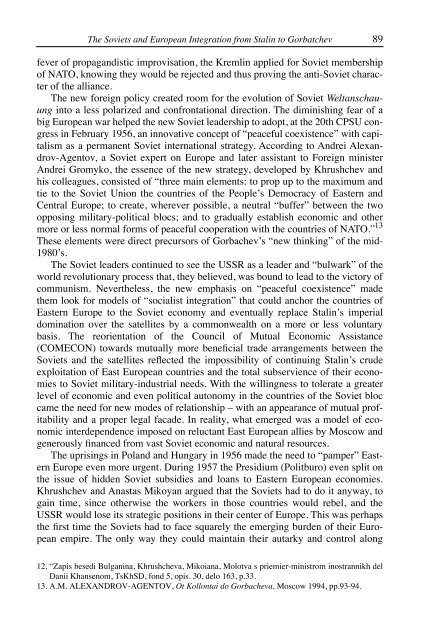journal of european integration history revue d'histoire de l ...
journal of european integration history revue d'histoire de l ...
journal of european integration history revue d'histoire de l ...
You also want an ePaper? Increase the reach of your titles
YUMPU automatically turns print PDFs into web optimized ePapers that Google loves.
The Soviets and European Integration from Stalin to Gorbatchev 89<br />
fever <strong>of</strong> propagandistic improvisation, the Kremlin applied for Soviet membership<br />
<strong>of</strong> NATO, knowing they would be rejected and thus proving the anti-Soviet character<br />
<strong>of</strong> the alliance.<br />
The new foreign policy created room for the evolution <strong>of</strong> Soviet Weltanschauung<br />
into a less polarized and confrontational direction. The diminishing fear <strong>of</strong> a<br />
big European war helped the new Soviet lea<strong>de</strong>rship to adopt, at the 20th CPSU congress<br />
in February 1956, an innovative concept <strong>of</strong> “peaceful coexistence” with capitalism<br />
as a permanent Soviet international strategy. According to Andrei Alexandrov-Agentov,<br />
a Soviet expert on Europe and later assistant to Foreign minister<br />
Andrei Gromyko, the essence <strong>of</strong> the new strategy, <strong>de</strong>veloped by Khrushchev and<br />
his colleagues, consisted <strong>of</strong> “three main elements: to prop up to the maximum and<br />
tie to the Soviet Union the countries <strong>of</strong> the People’s Democracy <strong>of</strong> Eastern and<br />
Central Europe; to create, wherever possible, a neutral “buffer” between the two<br />
opposing military-political blocs; and to gradually establish economic and other<br />
more or less normal forms <strong>of</strong> peaceful cooperation with the countries <strong>of</strong> NATO.” 13<br />
These elements were direct precursors <strong>of</strong> Gorbachev’s “new thinking” <strong>of</strong> the mid-<br />
1980’s.<br />
The Soviet lea<strong>de</strong>rs continued to see the USSR as a lea<strong>de</strong>r and “bulwark” <strong>of</strong> the<br />
world revolutionary process that, they believed, was bound to lead to the victory <strong>of</strong><br />
communism. Nevertheless, the new emphasis on “peaceful coexistence” ma<strong>de</strong><br />
them look for mo<strong>de</strong>ls <strong>of</strong> “socialist <strong>integration</strong>” that could anchor the countries <strong>of</strong><br />
Eastern Europe to the Soviet economy and eventually replace Stalin’s imperial<br />
domination over the satellites by a commonwealth on a more or less voluntary<br />
basis. The reorientation <strong>of</strong> the Council <strong>of</strong> Mutual Economic Assistance<br />
(COMECON) towards mutually more beneficial tra<strong>de</strong> arrangements between the<br />
Soviets and the satellites reflected the impossibility <strong>of</strong> continuing Stalin’s cru<strong>de</strong><br />
exploitation <strong>of</strong> East European countries and the total subservience <strong>of</strong> their economies<br />
to Soviet military-industrial needs. With the willingness to tolerate a greater<br />
level <strong>of</strong> economic and even political autonomy in the countries <strong>of</strong> the Soviet bloc<br />
came the need for new mo<strong>de</strong>s <strong>of</strong> relationship – with an appearance <strong>of</strong> mutual pr<strong>of</strong>itability<br />
and a proper legal faca<strong>de</strong>. In reality, what emerged was a mo<strong>de</strong>l <strong>of</strong> economic<br />
inter<strong>de</strong>pen<strong>de</strong>nce imposed on reluctant East European allies by Moscow and<br />
generously financed from vast Soviet economic and natural resources.<br />
The uprisings in Poland and Hungary in 1956 ma<strong>de</strong> the need to “pamper” Eastern<br />
Europe even more urgent. During 1957 the Presidium (Politburo) even split on<br />
the issue <strong>of</strong> hid<strong>de</strong>n Soviet subsidies and loans to Eastern European economies.<br />
Khrushchev and Anastas Mikoyan argued that the Soviets had to do it anyway, to<br />
gain time, since otherwise the workers in those countries would rebel, and the<br />
USSR would lose its strategic positions in their center <strong>of</strong> Europe. This was perhaps<br />
the first time the Soviets had to face squarely the emerging bur<strong>de</strong>n <strong>of</strong> their European<br />
empire. The only way they could maintain their autarky and control along<br />
12. “Zapis besedi Bulganina, Khrushcheva, Mikoiana, Molotva s priemier-ministrom inostrannikh <strong>de</strong>l<br />
Danii Khansenom, TsKhSD, fond 5, opis. 30, <strong>de</strong>lo 163, p.33.<br />
13. A.M. ALEXANDROV-AGENTOV, Ot Kollontai do Gorbacheva, Moscow 1994, pp.93-94.

















